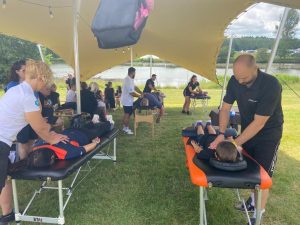As LiveWell Health stepped into the bustling halls of Adobe Office, we were greeted with enthusiasm and anticipation for a day of relaxation and rejuvenation. Settling into our designated area, we prepared to offer chair massages to the hardworking staff eager to unwind and destress.
With each gentle knead and soothing stroke, our skilled therapists worked their magic, melting away tension and leaving participants feeling refreshed and revitalised. As the day unfolded, it became evident that our chair massages were a hit among Adobe’s dedicated employees, who eagerly lined up for their turn in the massage chair.
Amidst the hum of activity and the occasional burst of laughter, a sense of tranquillity pervaded the atmosphere as individuals took a moment to prioritise their own well-being. From executives to interns, everyone had the opportunity to experience the restorative benefits of therapeutic touch, leaving them with a renewed sense of energy and focus.
As the day drew to a close, we couldn’t help but feel grateful for the opportunity to play a role in Adobe’s staff well-being day. It was a pleasure to witness the smiles and expressions of contentment on the faces of those we had the privilege to serve. At LiveWell Health, we understand the importance of self-care in maintaining a healthy work-life balance, and we’re honoured to be able to provide that support to organisations like Adobe.
As we packed up our massage chairs and bid farewell to the Adobe team, we left with a sense of satisfaction knowing that we had made a positive impact on the lives of others. Until next time, may each individual continue to prioritise their well-being and find moments of relaxation and rejuvenation amidst the demands of everyday life.
Fancy a wellbeing day yourself? Contact our corporate team for your onsite chair massage!







